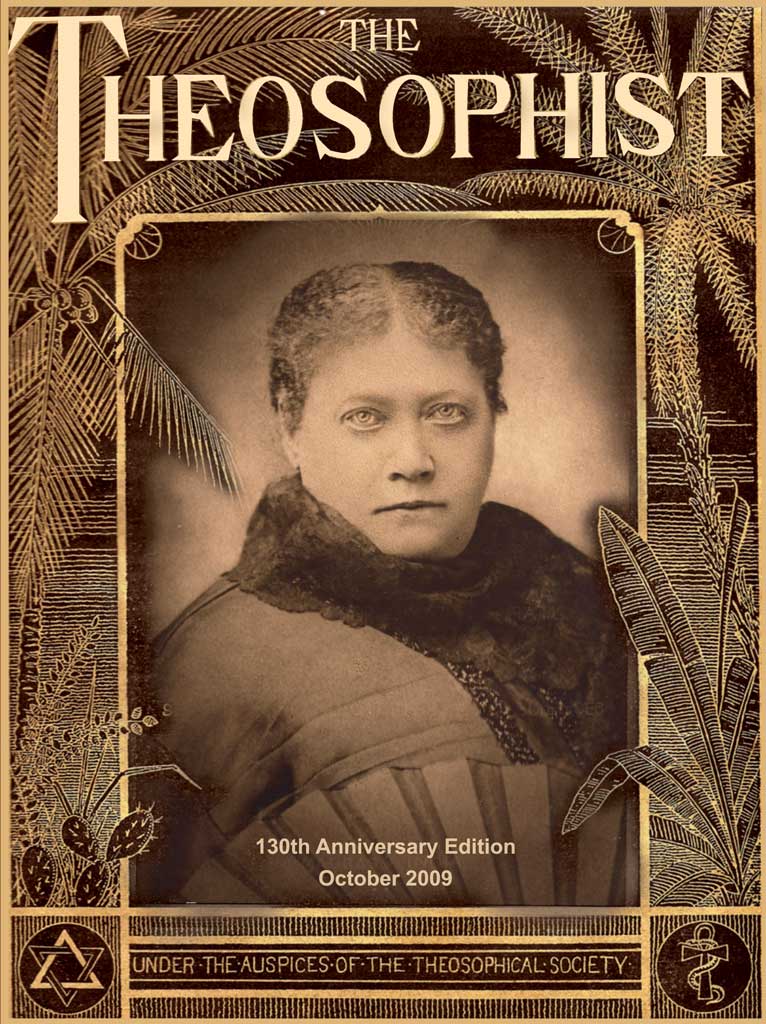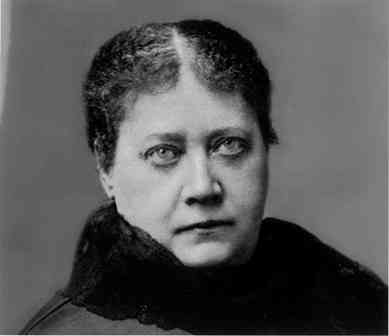
 |
HELENA P. BLAVATSKY! |
HELENA PETROVNA BLAVATSKY (1831 - 1891) is the dominant figure in the occult world of the 19th Century, and her influence has far outlived her, although the ideas she popularized are generally no longer connected to her within the incoherent New Age belief-set, and the religion she founded, Theosophy, no longer has a significant number of followers anywhere on earth.
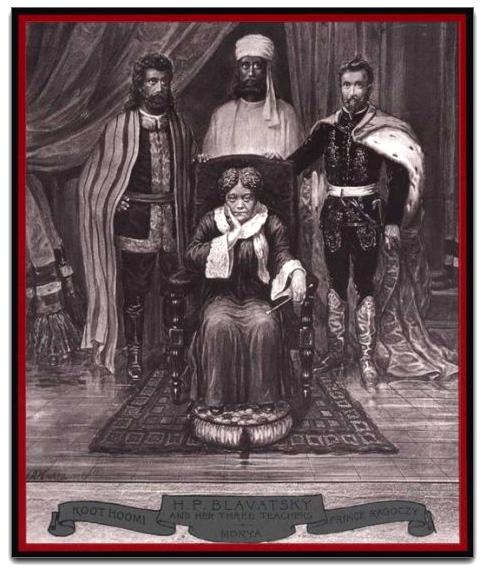 |
Reliable facts about her life are hard to come by. All her own “autobiographical” sketches are 100% fictitious. She was born to upper-class Russians, Peter and Helena von Hahn, and eloped at the age of 17 to marry 40-year-old General Nicephore Blavatsky. During the honeymoon, she bailed out and eventually wound up living with her grandfather. After a short while, three male would-be lovers moved in with her as well: her husband General Blavatsky, Baron Nicholas Meyendorff, and the otherwise obscure retired opera singer, Agardi Metrovich. By 1850, when Helena was not yet 20, Spiritualism was sweeping the world, and in comfort at Grandad's house, Helena started holding seances. I have found no description of these early sessions held for family and friends, but Helena was obviously a voracious and indiscriminate reader, and she soon became at least superficially familiar with most of the popular themes and interests of the day. It wasn't all that long (roughly around 1851) before Blavatsky, instead of communicating exclusively with spirits of dead relatives, found herself sometimes receiving wisdom from a superhuman but living man, who would eventually be identified as the Master Morya. The advantage of this kind of communication is obviously that the spiritualistic messages can then deal with almost any topic that is current. Over the years, a number of other Masters were added to the mix. I find no record of whether, at any time in her career, Blavatsky ever “materialized” Morya or any of the later Masters; in the majority of official Theosophical depictions, they do resemble the stereotypical materialized spirits of the day, wearing turban or helmet or head-dress or do-rag that completely conceals the hair, and long beard that conceals most of the face. As far as I can determine, all that ever “materialized” in later years related to these Supermen were a huge number of letters written by the Masters... letters that were usually in Blavatsky's own distinctive and unmistakable handwriting, until she had more assistants available. It seems more than likely that the original Morya was an imaginary playmate dating from Blavatsky's childhood! |
For around 20 years it is extremely difficult to get facts about what Helena Blavatsky was up to. She apparently made brief visits to cities like Paris and London, where she may have given seances as a test of the local waters. She continued to work as a medium mainly in Russia on and off for about a decade and a half after 1850. Although Helena maintained in later years that she was a virgin, and that this essential physical “purity” was the basis of her gigantic (ahem) spiritual powers, in fact she gave birth to a child in about 1861. The father is unknown, but was presumably Nicholas Meyendorff, since her other housemates General Blavatsky and Agardi Metrovich were well-stricken in years. The child, named Yuri, was sickly and crippled in some way, and died around the age of 5. The days of sponging off relatives whilst giving seances also came to an abrupt end by late 1869, when all possible family members who could have housed and fed Blavatski and her entourage either died or fell on financial hard times.
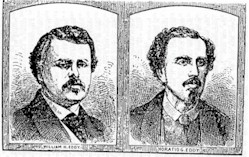 William and Horatio Eddy, Materializing Mediums 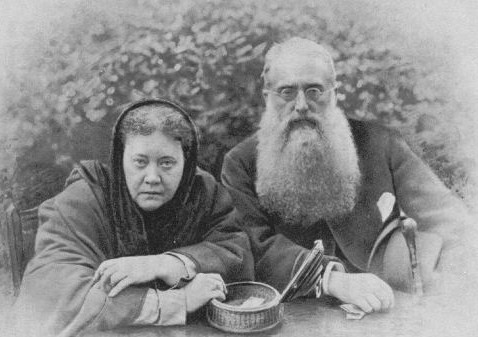
The Theosophical Twins, H. P. B. with Henry Steele Olcott. |
Clearly Helena thought that after 20 years of putting on seances, she had surely evolved a class act that deserved a wider audience, and one that would pay enough to support her; so, around 1870 she went to Egypt, in the company of at least one male companion and assistant, and set up shop as an exhibitor of inexplicable “occult phenomena.” This is also the date of the earliest surviving letters from good old Morya. In Egypt, Blavatsky became addicted to the smoking of (relatively mild) Egyptian cigarettes and she was a chain-smoker for the rest of her life, in an age when women never smoked at all, and most men smoked a pipe or cigars. She desperately needed, and promptly hired, a number of other experienced assistants, but nonetheless her “physical manifestations” turned out to be pretty primitive when compared to those of the competition and in 1873, Helena showed up in New York City. Spiritualism had begun in New York State in 1848, and that area, 25 years later, was still where the action was. That was the accepted place to pick up the newest tricks and techniques. There were some very lean months while the new immigrant settled in; at one point she worked in a sweat shop making artificial flowers for pennies a day. She still read voraciously, particularly newspapers and magazines to be found in the library reading rooms. The “big news” on the Spiritualism front in these days was being made not in New York State, but in remote Chittenden, Vermont, where the Eddy brothers, William and Horatio, held seances specializing in the cabinet materialization of large numbers of different spirits of the dead (usually supposedly male), in near-total darkness. When Blavatsky read a newspaper article (October 14, 1874) on these seances written by wealthy lawyer Henry Steele Olcott, she came to two conclusions that were to change her life completely: (1) Olcott was gullible to the point of needing a constant nurse, and (2) the Eddy brothers might have some presentational ideas worth adapting. |
She showed up promptly in Vermont and by arrangement with the Eddy brothers, she followed their seance with one of her own. With the help of assistant Michael Betanelly, she materialized spirit after spirit (usually male, all speaking Russian), and duly impressed Olcott, as was the intention. Olcott soon became a chum, and perhaps in an attempt to awaken his physical interest in her by now fat, dumpy, somewhat frog-like person, she married her assistant Betanelly. (Olcott had divorced his estranged wife shortly after meeting Blavatsky.) The spirits produced in Vermont were just about the only known full-figure materializations that Blavatsky is associated with; her more usual and more feminine specialty was the mysterious sudden appearance of small objects... a demonstration mediums usually call apports. At least in her early days in the US, Blavatsky at her seances made use of the standard “spirit guide,” in her case Pirate John King , aka Henry Morgan (who was also later the guide of nearly a dozen mediums, including the notorious Eusapia Palladino). King had a complex previous and subsequent history as a guide, having originally been concocted by the Davenport Brothers (who in fact did not claim any actual mediumistic powers, but did a stage spirit-cabinet act in music halls!). John King's daughter Katie King also became famous, particularly when materialized by the very sexy Florence Cook. Blavatsky's version of King was naturally given to writing letters, which mysteriously materialized during seances, and also, weirdly enough for a pirate, he produced delicate paintings on silk! Olcott got one, of course. [The earliest Blavatsky-produced King letters may date as far back as 1855, within a year of his invention by the Davenports!] When the Mahatmas took over completely, King seems to have vanished without trace, never to be heard from in subsequent Blavatsky seances. He is sometimes referred to by historians of Blavatsky's later career as an “undigested lump,” since he had no place at all in her later cosmic visions. To me the most single remarkable thing about Blavatsky's career is that, although her life was completely dominated by Spiritualism and seances from around 1850 to 1875, a long quarter of a century, there is essentially no trace of Spiritualism in her career and teachings after about 1876. All aspects and features of it were ruthlessly expunged, except for the prestidigitational techniques of apportation, a miracle which was attributed now to the living but godlike Mahatmas, rather than to spirits of the dead.
The next wrinkle for the team of Blavatsky and Olcott, who had become instant partners, was the founding of the very short-lived Miracle Club, supposedly devoted to investigation of the occult and supernatural. This organization sounds almost identical to one Blavatsky had earlier founded while in Egypt, which collapsed amidst scandals and fraud-accusations. They learned from the second failure and their next venture was to last, and change the direction both of religion and pseudoscience. It was The Theosophical Society, organized by Olcott and William Q. Judge in September of 1875. Blavatsky's task was to produce the scripture upon which the Society's occult teachings were based, and this she did in more than a year of feverish labor, culminating in Isis Unveiled (1877). It's a work of amazing imagination, but written in a strained mock-poetical style which renders it close to unreadable. Still, Holy Books are not often actually read, and are supposed to be difficult and obscure anyway. As a sly tribute to Olcott, Blavatsky invented another Master, originally called Cotthume [the Hume being a nod to another recent convert, Allan O. Hume], eventually evolving to Koot-Hoomi. Other Masters such as Djual Khoot (Dual Koot(!)) later Djual Khool, and Prince or Count Ragoczy aka St. Germain, eventually emerged. There was some danger for a while that each new wealthy prospective member of the cult to appear would be gifted with his own personal Mahatma to receive letters from.
|
Blavatsky as she expounded the teachings of Theosophy pulled out all the stops, combining ideas from various occult traditions with many rich strands of late 19th Century pseudoscience and science fiction drawn from her wide reading. You want Atlantis and Lemuria and giant ape-men and parallel universes and terrestrial evolution aided by Lords of the Flame, spiritually advanced men from Venus? You got it, and much, much more, from reincarnation to “white” magick, the aura, chakras, kharma, and secret after secret of supposedly long-lost Hermitic Philosophy. Only Spiritualism, and the lore of conventional Western religions, were excluded. Helena had been producing letters from Masters of Wisdom, aka Mahatmas, apparently for many years, and these letters (which generally appeared supernaturally in closed chests or cabinets) were full of material that could now be used within Theosophy. Olcott and Blavatsky felt, with good reason, that Western religious traditions were far more hostile to the Hermitic Wisdom of Theosophy than the various Eastern religions would be, and at the end of 1878, the two “Theosophical Twins” relocated to Adyar, India, where they found huge numbers of gullible and wealthy Anglo-Indians to court. Blavatsky ruled the large Adyar headquarters like a queen, and this period was probably the high point of her life. She dazzled the suckers with a wide repertory of conjuring tricks, causing filled teapots, flowers, jewelry and various small “lost” items to materialize in unlikely places. Naturally a large number of Mahatma Letters from the Masters of Wisdom also had to be produced, many of which were specifically addressed to important prospective members of the cult. In order to handle so many materializations and letters, Helena was forced to depend on assistants; some of these were native servants, others were old associates from her days as a spirit medium in Egypt. With so many cooks in the kitchen, exposure was almost inevitable, and over about a year from Spring 1884 to Spring 1885, various letters in newspapers and articles in magazines appeared, very accurately revealing the details of many aspects of Blavatsky's miracles, and in particular her ways of causing Mahatma Letters to materialize in various places, including falling from the ceiling or popping up inside a locked special shrine. |
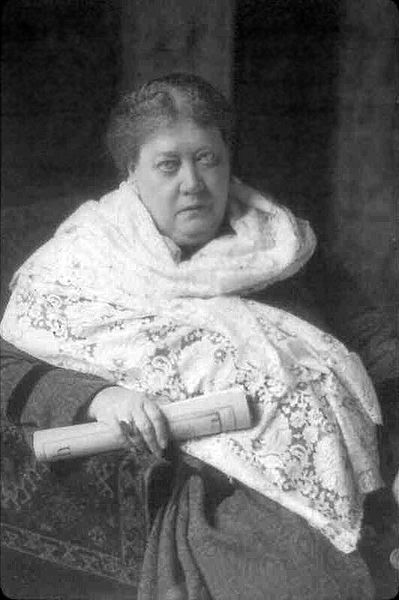
The last photo of HPB, taken just before her death in England. |
Blavatsky, on the advice of Olcott, was sent to Europe, where she sat down and produced a gigantic (two-volume) and more readable Bible for the movement, namely The Secret Doctrine (1888). Before her death from a variety of ailments in 1891, she settled in England and produced two more short works, The Key to Theosophy and The Voice of Silence. According to Blavatsky, as she had traveled the world in her younger days defending her virtue and delving for lost secret wisdom, she had visited Tibet, where because of her already superhumanly advanced state of spiritual evolution she had been able to locate the secret mountain headquarters of the Mahatmas, and had been shown and allowed to read The Book of Dzyan, which contained the entire history of the universe. It was fairly easy for scholars later to identify the huge number of actual sources that Blavatsky used, since she tended to use them verbatim instead of in disguised paraphrase. Much of Theosophy depends upon supposed principles of Tibetan religion, but in fact in her day almost nothing was known about any actual religious traditions of that isolated, insulated, forbidden region; her imagination supplied all the details.
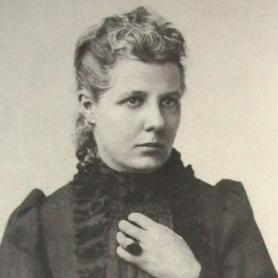 Anne Besant |
After Blavatsky's death, Theosophy throve for a short while under the energetic leadership of Anne Besant. Indeed, it seems to me that Theosophy reached its peak of popularity, especially among British and American writers, artists and the arty set, around 1900 - 1910. Since then, its decline has been steady and relentless. Newer, more influential figures appeared, such as Rudolph Steiner and Alice A. Bailey, who created their own independent variations of the original, aided by their own personal Mahatmas. [Bailey borrowed Djwhal Khul, whom she very soon and very wisely renamed slightly.] L. Ron Hubbard's circa 1950 new religion of Scientology owes a tremendous debt to Theosophy, particularly in the way it mingles many completely unrelated pseudoscientific and science-fictional themes. Edgar Cayce and Manly P. Hall also did much to popularize what were basically Theosophical themes; when the so-called New Age religious movement began to emerge in the 1980s, most New Agers would have never heard of Helena Blavatsky, yet her influence is everywhere to be found within the seemingly random collage of unrelated and incoherent beliefs that characterize The New Age. California, in particular, had been a hotbed of Theosophy and variant offshoots from the beginning of the 20th Century. Blavatsky disciple Katherine Tingley established a huge “campus” devoted to Theosophical studies at Point Loma; by the 1930s, a wild offshoot, the so-called I AM Activity, was gaining an impressive numbers of followers, and even relatively recent 1930s immigrants to California such as George Adamski were feverishly creating their own variants. |
One of the most vivid word-portraits of Blavatsky I have found is contained in a book by M. D. Conway, published in 1906. He visited Adyar in Helena's heyday, hoping to witness and figure out the conjuring tricks behind the various increasingly famous “miracles” she was supposed to exhibit. But let him tell it: “She sat in her large decorated chair, in an airy white beltless gown much in the style of the midsummer dress of Russian ladies, endlessly smoking cigarettes, conversing in a free and easy way, and putting on no airs at all. Madame was not pretty, but she was a notable figure, her eyes capable of every variety of expression, and her humour always playing.”
“At a certain moment when we happened to be alone on the veranda madame arose and asked me to follow her. She led me through a hall and along a corridor, then up a stairway to a boudoir richly decorated. There she invited me to take a seat, and proffered a box of cigarettes, lighting one for herself. I preferred my cigar, and was ready for an apparently intended encounter. She asked what was my particular proposal or desire. I said, ‘I wish to find out something about the strange performances attributed to you. I hear of your drawing teapots from under your chair, taking brooches out of flowers, and of other miracles. If such things really occur I desire to know it, and to give a testimony to my people in London in favour of Theosophy. What does it all mean?’”
“She said with a serene smile, ‘I will tell you, because you are a public teacher [here she added some flattery], and you ought to know the truth; it is all glamour — people think they see what they do not see — that is the whole of it.’”
“It was impossible not to admire the art of this confession. Mme. Blavatsky, forewarned by Professor John Smith of my intended investigation, had arranged precisely the one maneuver that could thwart it. Had I continued it, cross-examining her adherents, proposing plans for verification, I might have awakened doubts and suspicions among her ‘neophytes.’ But she spiked my guns; her confession was made without witnesses, and should I use it publicly it was easy enough to say I had misunderstood her. And moreover she had used the vague word ‘glamour,’ which might preserve her personal throne while giving up the reality of the things attested by her miracles.”
“ I did not press the matter at all. I felt that madame was a genius in her way, and a moral phenomenon to be studied, but she made no pretences with me. Of the common Theosophic talk about a new era, welfare of humanity, reincarnation, there was no trace whatever. Not a word about ‘Occultism’ or any other ‘ism’ came from her, nor anything in the way of an abstraction. She gossiped wittily and sometimes satirically about this or that person she had met in America, London, Paris, and told amusing anecdotes.”
BLAVATSKY AND DANIEL HOME: One mystery about Blavatsky's career I have not been able to shed much light on is her connection to fellow medium Daniel Home. It is frequently said that Blavatsky worked as an assistant to Home, briefly, but this can hardly be true, since Home famously always worked alone, and always as an invited guest in a private home. He never held public seances. Blavatsky's lover Baron Nicholas Meyendorff did know Home, and in fact was supposedly a great friend of Home's. However, in various letters, Blavatsky says she never met Home, and there seems no reason to doubt this assertion. In Home's (ghostwritten) book Lights and Shadows of Spiritualism (1877) he spends quite a bit of time making laborious fun of the gullibility and foolishness of Henry Steele Olcott, although he doesn't name him specifically, other than as the author of a certain notably foolish book on spiritualism, People from the Other World (1875), and as the President of the recently-formed Theosophical Society. Blavatsky comes in for a mention only indirectly as Home sarcastically quotes Olcott's careless and contradictory remarks about the incredible mediumistic powers of a female “fellow Theosophist.” Home says nothing about any direct personal knowledge of her, present or past. He is particularly sarcastic about one of her highly-publicized materialization feats, she having supposedly produced a belt buckle which she said she had supernaturally extracted from the tomb of a decorated military hero in Russia. In some accounts this belt buckle and some military decoration or other are said to have been teleported from the grave of her own father... in which case it isn't particularly surprising if the item was already in her possession as a keepsake, to be produced as needed. One version of the story, which might be the correct one, is that during the seance conducted by Blavatsky in Vermont a figure appeared in costume-shop Russian military uniform and Blavatski exclaimed, “Are you my father?” The figure, her assistant Michael Betanelly in one of many costumes he wore that night, removed his belt and a medal and presented them to Blavatsky. Presumably he was handing them back to the lady who had given them to him a short time before to add some authenticity to the music-hall costume.
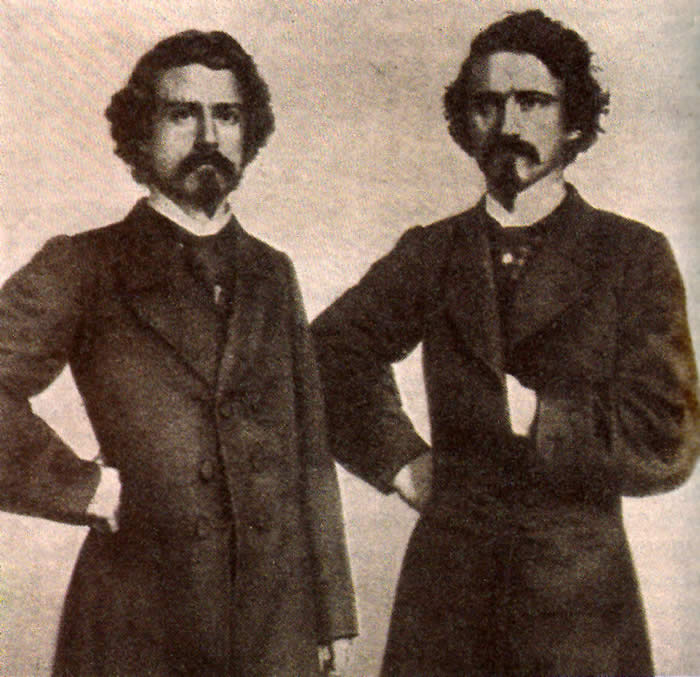
The Davenport Brothers, music hall performers of a magic act based on Spiritualism, were a rich source of material for many professional mediums, including Helena Blavatsky. |
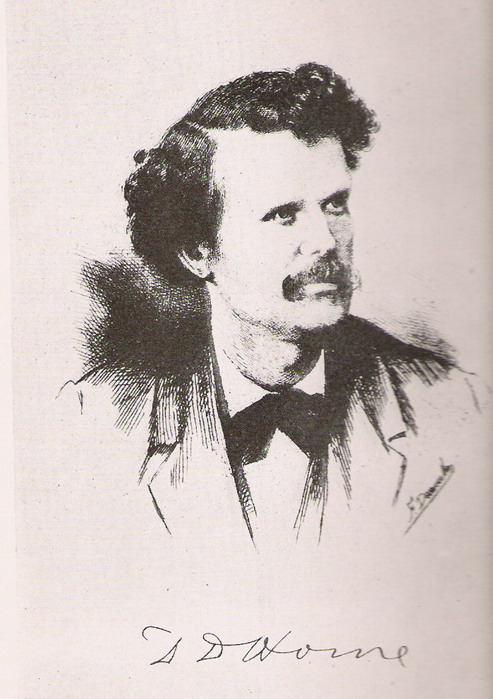 Daniel D. Home, the most famous medium of the day, had no respect whatsoever for the mediumistic skills of Blavatsky. |
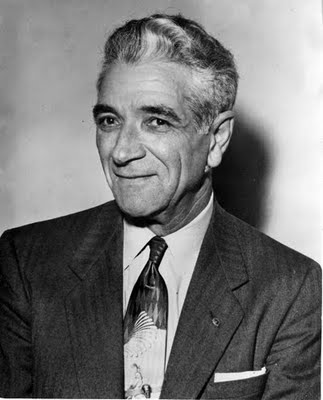 George Adamski was one of many 20th Century American con-men who sought to repackage and cash in on themes from Theosophy. |
